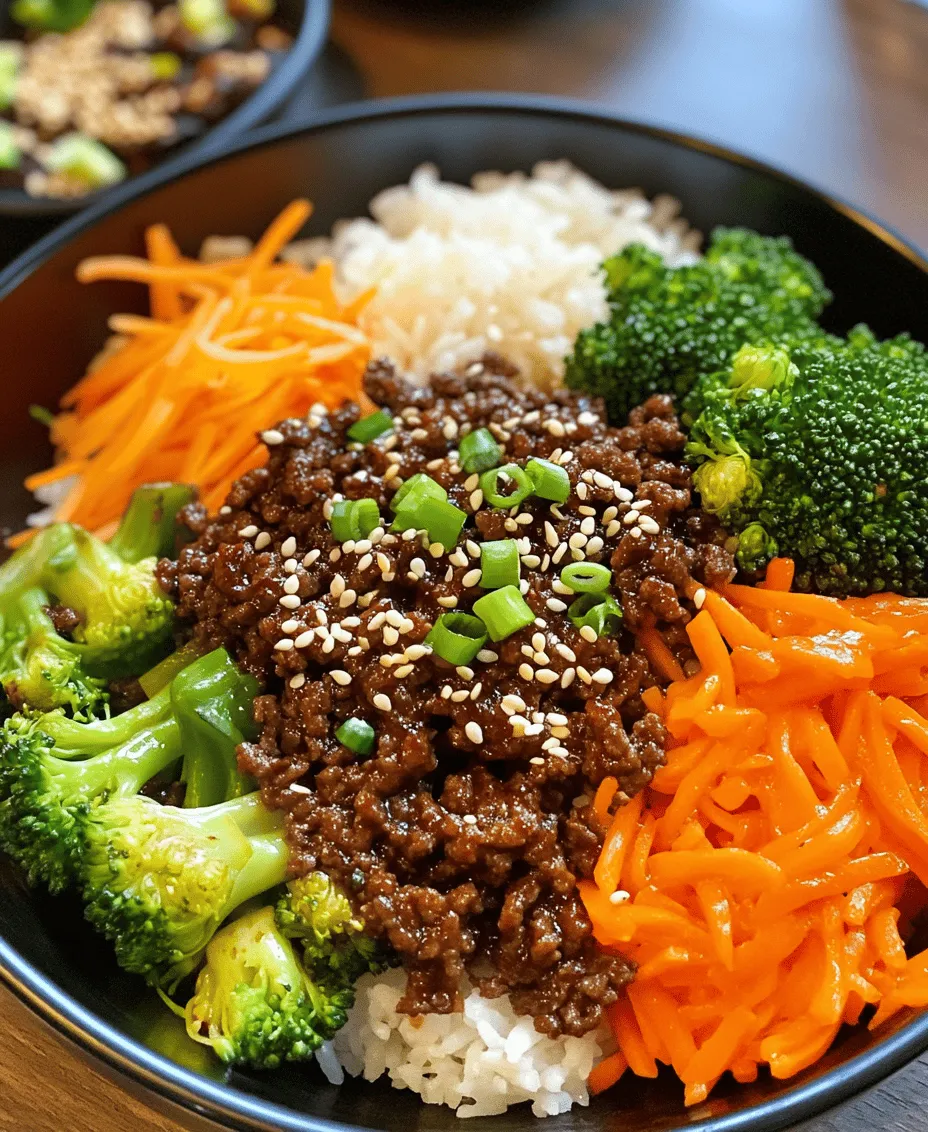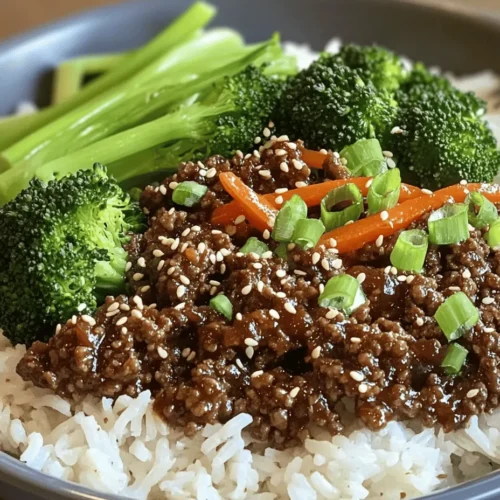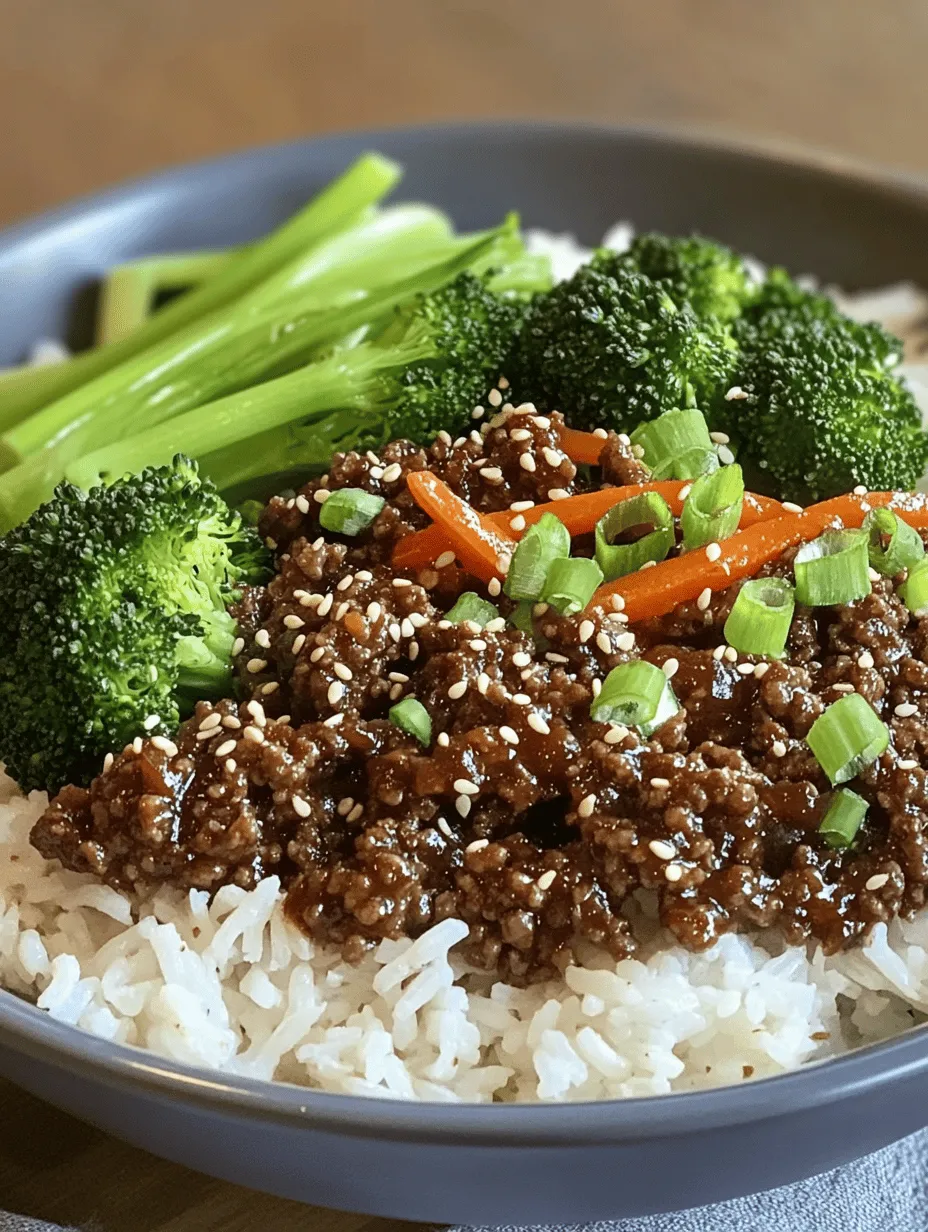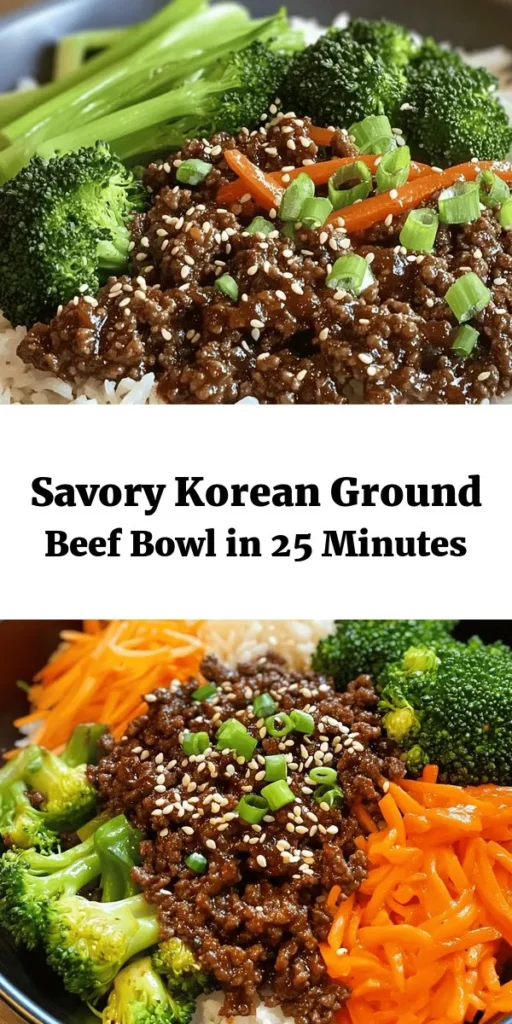Introduction
Korean cuisine has gained immense popularity worldwide, not only for its bold flavors but also for its vibrant presentation and healthful ingredients. As a harmonious blend of flavors and textures, Korean dishes often feature a balance of sweet, savory, and spicy elements that tantalize the palate. Among these culinary delights, the Korean Ground Beef Bowl stands out as a quick, satisfying, and deeply flavorful meal that caters to both busy weeknights and casual gatherings.
The Korean Ground Beef Bowl is a perfect representation of the essence of Korean cooking—simple yet delicious. With its tender, seasoned beef served over a bed of fluffy jasmine rice and colorful vegetables, it offers a delightful experience for both the eyes and the taste buds. This dish is not just about feeding the body; it’s a celebration of the rich heritage of Korean flavors.
One of the key elements that makes Korean cuisine so appealing is the emphasis on balance. Each ingredient plays a significant role, contributing to the overall taste and nutrition of the dish. The combination of savory and sweet, along with the freshness of vegetables and the warmth of spices, creates a meal that satisfies cravings while providing a well-rounded dining experience.
Understanding the Ingredients
To create an authentic Korean Ground Beef Bowl, it’s essential to understand the role of each ingredient. This not only enhances the flavor of the dish but also enables you to make better choices when shopping for your ingredients.
Ground Beef: Choosing the Right Fat Content for Flavor
The star of the Korean Ground Beef Bowl is undoubtedly the ground beef. When selecting ground beef, aim for a blend with a moderate fat content, typically around 80/20 (80% lean, 20% fat). This ratio provides enough fat to keep the meat juicy and flavorful while allowing for a good sear. Ground beef with too high a fat content may lead to a greasy dish, while very lean beef can result in dryness.
Soy Sauce: The Backbone of Umami in Korean Dishes
Soy sauce is a staple in Korean cooking and serves as the backbone of umami flavors in this dish. It adds depth and richness, enhancing the savory notes of the ground beef. For the best flavor, consider using a high-quality, naturally brewed soy sauce. If you prefer a gluten-free option, tamari is a great alternative that maintains the same umami profile.
Brown Sugar: Balancing Savory with Sweetness
Brown sugar is another crucial ingredient that helps to balance the savory notes of soy sauce and the richness of the beef. It adds a subtle sweetness that complements the dish without overpowering it, creating a well-rounded flavor. The caramelization that occurs during cooking also contributes to the overall complexity of the dish.
Sesame Oil: Adding a Nutty Aroma
Sesame oil is a key player in Korean cuisine, known for its rich, nutty aroma. Just a drizzle adds an incredible depth of flavor to the ground beef, making it taste more authentic. Use toasted sesame oil for a more robust flavor, but be sure to use it sparingly, as its strong taste can easily dominate the dish.
Garlic and Ginger: Essential Aromatics in Korean Cooking
No Korean dish is complete without aromatics, and garlic and ginger are essential in this recipe. Freshly minced garlic provides a pungent kick, while ginger adds warmth and zest. Together, they create a fragrant base that elevates the flavor profile of the ground beef.
Red Pepper Flakes: Adjusting the Heat Level
For those who enjoy a bit of spice, red pepper flakes are the perfect way to add heat to the dish. The beauty of this recipe lies in its flexibility; you can adjust the amount of red pepper flakes according to your heat tolerance. For a milder flavor, use less, or for a spicier kick, feel free to add more.
Green Onions: Enhancing Freshness and Flavor
Green onions, or scallions, add a fresh, crisp element to the Korean Ground Beef Bowl. They are typically used as a garnish, providing a pop of color and a mild onion flavor that brightens up the dish. For an added crunch, consider using the green tops in your assembly.
Jasmine Rice: The Perfect Base for the Bowl
Serving the ground beef over a bed of jasmine rice not only provides a comforting foundation but also complements the dish beautifully. Jasmine rice is known for its fragrant aroma and slightly sticky texture, making it ideal for holding the flavorful beef and sauce. If jasmine rice isn’t available, short-grain rice or even cauliflower rice can serve as alternatives.
Broccoli and Carrots: Nutritional Benefits and Color Contrast
Incorporating vegetables like broccoli and carrots not only boosts the nutritional value of the Korean Ground Beef Bowl but also adds visual appeal. Broccoli provides a nice crunch and is rich in vitamins, while carrots add sweetness and a vibrant orange color. Together, they create a well-rounded meal that is as good for you as it is delicious.
Sesame Seeds: Final Touches for Texture and Flavor
To finish off your Korean Ground Beef Bowl, a sprinkle of sesame seeds adds a delightful crunch and enhances the nutty flavors from the sesame oil. Toasted sesame seeds can be used for an extra layer of flavor. They not only contribute to the overall taste but also elevate the presentation of the dish.
Preparation Steps for the Korean Ground Beef Bowl
Now that we have a solid understanding of the ingredients, let’s dive into the preparation steps that will bring this flavorful dish to life. Follow these detailed instructions for a successful Korean Ground Beef Bowl that will impress your family or guests.
Preparing the Sauce: Importance of Marinating and Flavor Melding
Start by preparing the sauce, as this will serve as a marinade for the ground beef. In a medium bowl, combine soy sauce, brown sugar, sesame oil, minced garlic, minced ginger, and red pepper flakes. Whisk these ingredients together until the sugar dissolves and the mixture is well blended. Allow it to sit for a few minutes, letting the flavors meld together. If you’re a fan of meal prep, this sauce can be made in advance and stored in the refrigerator for a few days, saving time on busy nights.
Cooking the Ground Beef: Techniques for Achieving the Perfect Browning
Heat a large skillet or wok over medium-high heat. Once the pan is hot, add the ground beef. Allow it to brown without stirring for the first minute or two; this helps develop a nice, caramelized crust. Once the meat starts to brown, break it apart with a spatula and continue cooking until it’s fully browned and cooked through, usually about 5-7 minutes. Make sure to drain excess fat if needed, especially if you’re using fatty ground beef.
Adding Aromatics: How to Enhance the Dish’s Flavor Profile
With the ground beef cooked to perfection, it’s time to add the aromatics. Lower the heat slightly, then add the minced garlic and ginger to the skillet. Sauté them for about 30 seconds, stirring frequently to prevent burning. This brief cooking time releases their essential oils and infuses the beef with flavor. The aroma will be intoxicating, setting the stage for the next steps.
Combining Sauce with Beef: Ensuring Even Distribution of Flavors
Pour the prepared sauce over the browned beef, stirring well to ensure that every piece is coated. Allow the mixture to simmer for an additional 2-3 minutes, letting the flavors combine and the sauce thicken slightly. This step is crucial for achieving that signature Korean flavor profile. Taste and adjust the seasoning if necessary, adding more soy sauce or sugar to suit your palate.
Sautéing Vegetables: Retaining Crunch While Cooking
In a separate pan, heat a small amount of oil over medium heat. Add the broccoli florets and sliced carrots, sautéing them for about 3-4 minutes until they are bright in color and just tender. You want to retain their crunch, so avoid overcooking. If you prefer a bit of char, you can increase the heat and give them a quick stir-fry.
Assembling the Bowl: Layering Ingredients for Visual Appeal and Taste
Now that all the components are ready, it’s time to assemble your Korean Ground Beef Bowl. Begin by scooping a generous portion of jasmine rice into a bowl. Top it with the ground beef and sauce mixture, making sure to distribute it evenly. Add the sautéed broccoli and carrots on the side for a colorful presentation. Finally, garnish with chopped green onions and a sprinkle of sesame seeds to finish off the dish.
This Korean Ground Beef Bowl is not just a meal; it’s a culinary experience that brings the flavors of Korea right to your kitchen. With its quick preparation and satisfying taste, this dish is sure to become a favorite in your household. Enjoy the process of cooking and the delightful flavors that await!

Garnishing: The Role of Aesthetics in Food Presentation
Garnishing a dish is not merely about making it look good; it’s about enhancing the overall dining experience. When it comes to the Korean Ground Beef Bowl, the right garnishes can elevate the dish’s visual appeal, making it more inviting and appetizing. A splash of color from fresh herbs or a sprinkle of sesame seeds can transform a simple meal into a feast for the eyes.
Consider adding finely chopped green onions or cilantro for a burst of freshness. You could also include thinly sliced radish for a crisp texture and vibrant color. These garnishes not only add aesthetic value but also contribute to the flavor profile, creating a harmonious blend that invites your guests to dig in.
Nutritional Information
Understanding the nutritional value of your meals is essential, especially when preparing dishes like the Korean Ground Beef Bowl that are both delicious and satisfying. Here’s a breakdown of the calories and nutritional values per serving, along with the health benefits of the main ingredients.
Breakdown of Calories and Nutritional Values per Serving
A typical serving of the Korean Ground Beef Bowl (approximately 1 cup) contains about 450-500 calories, depending on the specific ingredients and portions used. Here’s a general breakdown:
– Calories: 450-500
– Protein: 25-30 grams
– Carbohydrates: 40-50 grams
– Fats: 20-25 grams
– Fiber: 4-6 grams
Health Benefits of the Main Ingredients
1. Protein Content from Ground Beef: Ground beef is an excellent source of high-quality protein, which is crucial for muscle repair and growth. It also provides essential amino acids that our bodies cannot produce on their own.
2. Fiber and Vitamins from Broccoli and Carrots: Both broccoli and carrots are rich in dietary fiber, aiding in digestion and promoting a healthy gut. They are also packed with vitamins and minerals; for instance, broccoli is high in vitamin C, while carrots are an excellent source of beta-carotene, which the body converts into vitamin A.
3. The Impact of Sesame Oil on Heart Health: Sesame oil, a key ingredient in this dish, is known for its heart-healthy properties. It contains unsaturated fats and antioxidants, which can help lower cholesterol levels and improve overall heart health. Additionally, sesame oil has anti-inflammatory properties that contribute to long-term wellness.
Variations and Customizations
One of the best aspects of the Korean Ground Beef Bowl is its versatility. You can easily adapt this recipe to suit your tastes or dietary needs. Here are some suggestions for ingredient substitutions and enhancements:
– Using Ground Turkey or Chicken for a Lighter Option: If you’re looking for a leaner protein source, consider using ground turkey or chicken instead of beef. These alternatives will reduce the overall fat content while still providing ample protein.
– Alternative Vegetables for Different Textures and Flavors: Feel free to mix and match vegetables based on what you have on hand or your preferences. Bell peppers, snap peas, and zucchini can add different textures and flavors, enhancing the dish’s overall appeal.
– Gluten-Free Soy Sauce for Dietary Restrictions: If you or someone you’re serving has a gluten intolerance, you can substitute regular soy sauce with gluten-free soy sauce or tamari without sacrificing flavor.
– Ideas for Adding Extra Toppings or Sides: Consider adding extra toppings to personalize your bowl. Sesame seeds, crushed peanuts, or a drizzle of spicy Sriracha can add an exciting kick. For a side, serve kimchi, a traditional Korean fermented vegetable dish, which adds a tangy flavor and probiotics to promote gut health.
– Fried Egg: For Added Richness: A fried egg on top of your Korean Ground Beef Bowl adds a delightful richness and creaminess that complements the savory beef and vegetables beautifully.
Serving Suggestions
The Korean Ground Beef Bowl is not only versatile in terms of ingredients but also in how and when you serve it. Here are some ideal occasions for enjoying this dish:
– Quick Weeknight Dinners: With a preparation time of about 30 minutes, this dish is perfect for busy weeknights when you want something nutritious yet quick.
– Meal Prep for Busy Weeks: The Korean Ground Beef Bowl is an excellent option for meal prep. You can batch-cook the beef and vegetables, then store them in individual containers for easy grab-and-go meals throughout the week.
– Casual Gatherings with Friends and Family: Whether it’s a casual dinner with friends or a family gathering, this dish can be made in larger quantities, allowing everyone to enjoy a hearty meal together.
Pairing Recommendations with Drinks or Additional Dishes
To enhance your dining experience, consider pairing the Korean Ground Beef Bowl with complementary beverages or side dishes. Here are some suggestions:
– Suggested Beverages: A light, crisp lager or a fruity soju can provide a refreshing contrast to the savory flavors of the bowl. For a non-alcoholic option, try a sparkling water with a hint of lime.
– Additional Dishes: Serve with a side of Korean cucumber salad for a refreshing crunch, or include a simple miso soup to round out the meal.
Conclusion
In summary, the Korean Ground Beef Bowl is a simple yet satisfying meal that celebrates the vibrant flavors of Korean cuisine. With its balance of protein, vegetables, and healthy fats, this dish is not only delicious but also nutritious, making it an excellent choice for any occasion.
We encourage you to explore the rich world of Korean flavors and cooking techniques. Whether you’re a seasoned cook or a novice in the kitchen, preparing and sharing meals like this can bring joy and connection to your dining experiences. Embrace the creativity of cooking, and enjoy the process of serving up delicious dishes that your loved ones will cherish.



